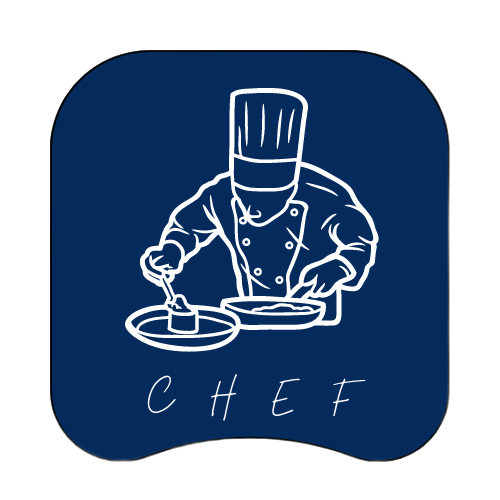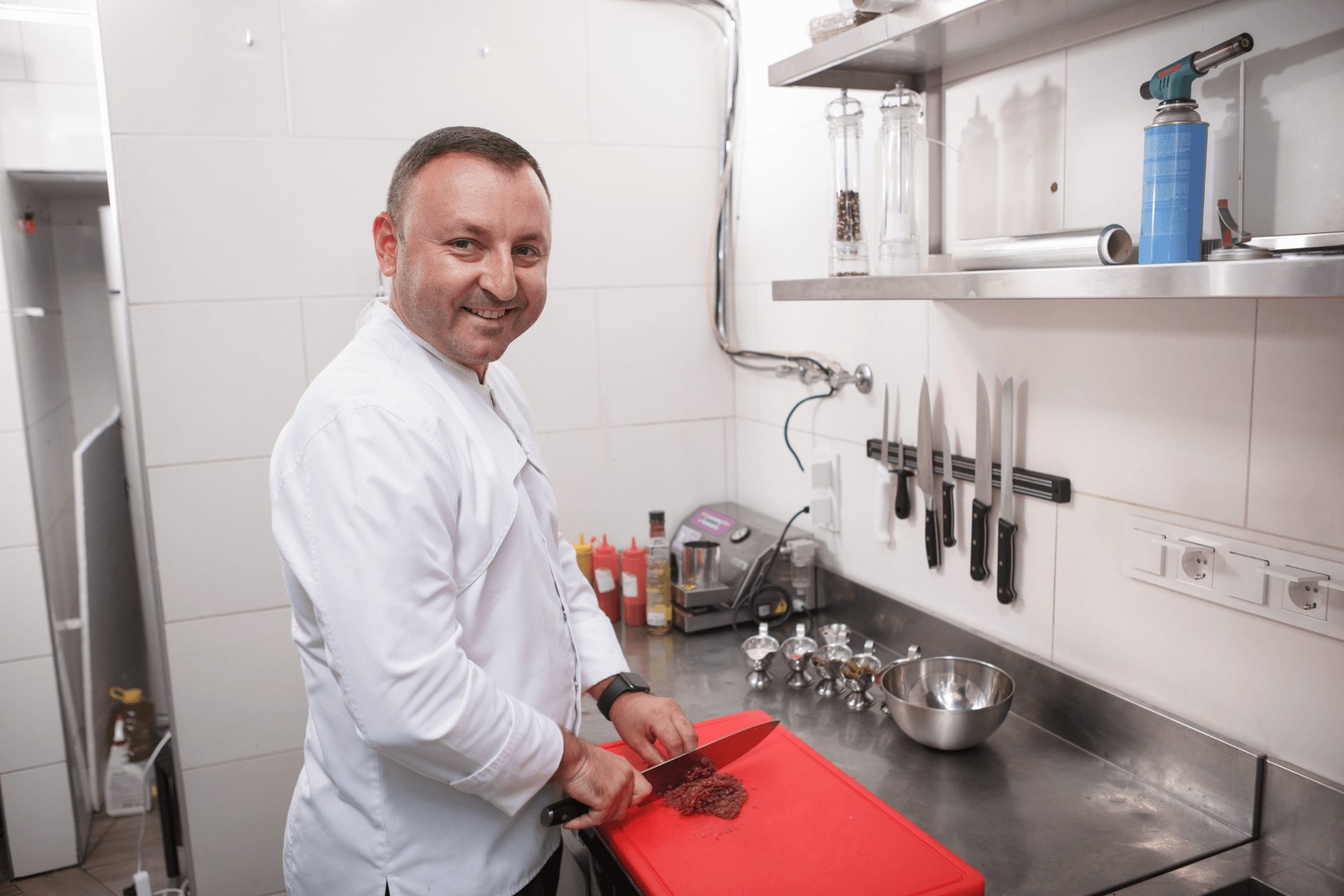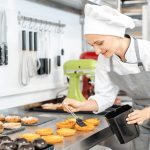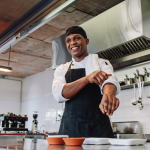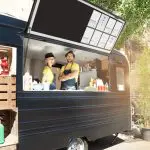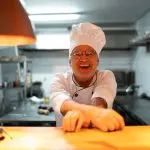The colour coded chopping board system; (Always check the company procedures. As this is the common system but not all workplaces follow this exact system)
The Red Chopping Board – Raw meet
A red chopping board is used for high-risk foods including chicken and other raw meats.
The Blue Chopping Board – Raw Fish
The blue chopping board is used for the preparation of raw fish.
The White Chopping Board – Dairy
The white chopping board is used for dairy products, such as the cutting of cheese.
The Yellow Chopping Board – Cooked Meats
The yellow chopping board is used for the preparation of cooked meats.
The Brown Chopping Board – Vegetables
The brown chopping board is used for the preparation of vegetables, such as root vegetables.
The Green Chopping Board – Salads and Fruits
The green chopping board is used for the preparation of products such as cucumbers and oranges.
The Purple Chopping Board – Nuts (Check company policy)
In professional kitchens, chefs will mainly be using plastic colour coded chopping boards. Although there are other materials a chopping board can be made from including wooden chopping boards.
Wooden chopping boards are more common in the home kitchen used by the home chef.
Want To Skip Ahead?
- The 6 Main Colour Code Chopping Boards
- The Chopping Board System
- Chopping Boards Health And Safety
- How To Use A Chopping Board Safely
- What Is The Green Chopping Board Used For
- The Types Of Food To Cut On A Green Chopping Board
- Why Is My Board Loosing It’s Colour
- How To Give A Chopping Board A Deep Clean
Colour Coded Plastic Chopping Boards
There are six main colours of chopping boards used in professional kitchens today. These colours relate to a specific type of food to help prevent cross-contamination.
It’s advised for kitchens to stick to the colour coded chopping board system, to help prevent cross-contamination. Here is a video explaining the colour coded chopping board system.
Many places use the common colour coded chopping board system, however, this is not a legal requirement.
The establishment will need to have a colour coded chopping board system that they use.
The most important thing is that the chefs work clean.
Many places use this system, however this is not a legal requirement. Attentive cleaning and a set chopping board system that all staff are trained on, including the front of house staff is most important.
Some places may have a colour coded board for the preparation of nuts, this can be a purple chopping board. This helps to prevent allergy cross-contamination.
There are no set laws on using set colour-coded chopping boards for specific foods. It is possible to use any colour chopping board as long as it is cleaned and disinfected before it is used for another product.
This can cause opinions to differ and different places may have their own set rules on using colour coded chopping boards that need to be stuck to.
What are the hazards when using the chopping board system?
Potential Colour Coded Chopping Board Hazards
A potential cross contamination hazard in doing so is when an employee has been trained in a previous place to use the common set chopping board guide to a new place that does not.
Such as; a red board is used for preparing a high-risk product, maybe chicken. And in the new place, the red board is used for a different product. Such as cutting cheese for a cheese board.
Although the most important area is the correct cleaning of the chopping board before each job, to prevent cross-contamination and also allergen contamination.
Advice and Tips When Using Colour Coded Chopping Boards
To use a chopping board make sure you choose the correct colour of board for the product you will be preparing.
The colour coded chopping board system should be followed that the place you are working in follows, this may vary to the general colour coded chopping board system.
Chopping boards may come in different sizes however there are two main sizes used this will depend on the workplace.
How To Use A Chopping Board Safely
It is important to make sure the chopping board is securely placed on the work surface.
To safely secure the chopping board to the surface dampen some kitchen paper and place a small piece under each corner of the chopping board.
Make sure your chopping board is safely secured, a chopping board that is not safely secured will move around on the work surface and is a potential hazard for cuts.
Also, it is good practice to dispose of the chopping board correctly, such as after using a red chopping board for cutting raw meats or raw fish to take the chopping board straight to the wash-up area.
Once your ingredients are safely prepared you will be cooking sauces and dishes.
What Is A Green Chopping Board Used For?
I have been asked this question a few times, what is a green chopping board used for? To follow are
some answers to this question. I have given an answer to this and also some other tips about the green chopping board.
What the board is used for, how to use safely and the sizes of boards available.
A green chopping board is a part of the chopping board system in the UK.
Typically, this is the system used by the majority of places and that is also taught at catering colleges.
The Green Chopping Board
They can be used on both sides. Typically one side will be used and once dirtied can be turned over and the other side used.
What Is A Standard Green Chopping Board Made Of?
In professional kitchens we mostly use the high density, hygiplas, non absorbent Style. They are made of the material polyethelene. The boards come in 3 main sizes these are:
Small: 12(H) x 305(W) x 229(L)mm
Standard: 12(H) x 450(W) x 300(L)mm
Large: 12(H) x 600(W) x 450(L)mm
How To Safely Use A Colour Coded Chopping Board When Cutting Ingredients
And also safety in mind when using. The boards will naturally slide around on the work surface. This can be very dangerous when cutting through ingredients.
There are a few ways to stop this:
A non slip matt can be placed under the board,
A clean damp clothe can be placed under,
Four pieces of damp paper towel can be placed under each corner to hold the board in place,
A damp jay clothe can also be used.
What Types Of Food Are Prepared On This Board?
The green colour coded chopping board is used for fruits and vegetables.
Asparagus,
Aubergenes
Artichokes (Eggplant)
Bananas
Beetroot
Garlic
Onions
Tomatoes
Cucumber
Butternut Squash
Leeks
Courgettes (Zucchini)
Peppers
Pineapple
Apples
Grapes
Fruit And Salads
What Else Do I Need To Be Aware Of?
When cutting a vegetable such as a beetroot the board will be heavily coloured in the vegetables colour.
Make sure the board is turned over or a clean one is used for the next job. And also, when cutting onions make sure the same is done.
The onion will leave an onion flavour on the board. Therefore the next ingredient will have an oniony taste if used straight afterwards.
Where Can I Buy A Green Chopping Board?
Green chopping boards can be brought from a catering equipment supplier. One of the most popular in the UK for chefs being Nisbets. Other places include: Amazon and Argos.
Why Is My Green Chopping Board Loosing Its Colour?
Once the chopping board has been used many times the board will start to loose its colour. And this is due to the chef working on the board and being cleaned.
And also, they will pick up some scrapes and scratches. Possibly burn marks too, occasionally a very hot tool can be left on the surface. This can cause the surface to melt.
How Do I Give The Board A Deep Clean?
Over time the boards will need to be deep cleaned, in many kitchens this is done once a week. The boards can be soaked over night in water and a suitable cleaning product.
And in the morning the boards will need to be cleaned and rinsed thoroughly so they can be safely used.
